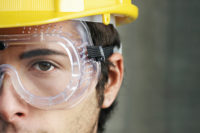ANSI fall protection standards: Keep up with changing practices & equipment

Why these changes matter
Some of you may be asking yourself, how does this concern me since OSHA regulations have not changed? ANSI standards are continually changing or evolving as fall protection practices and/or equipment make advances in the industry. OSHA regulations change slowly with the last significant change in fall protection being in 1995 (OSHA 1926 Subpart M).
Where you may be most affected by ANSI are the “best practices” that ANSI Z359 Standards offer. Though ANSI standards are not regulation, they are considered “best practices” and offer you the opportunity to improve safety in your workplace. Many large corporations have adopted these standards and expect their contractors to adopt them as well.
Keeping informed of new ANSI standards should be paramount in your business. There are many ways to keep up to date on new ANSI Standards that may affect you. Here are a few ideas:
1. Buying ANSI standards: Copies of the standards themselves are not printed on the web. Copies of specific ANSI Standards can be purchased through the following publisher organizations — American Society of Safety Engineers (ASSE) or the International Safety Equipment Association (ISEA) and elsewhere. The proceeds go to funding past and present administration of future standard writing and publication.
2. Become a member: Become a member of an organization such as the American Society of Safety Engineers (ASSE) or the International Society for Fall Protection (ISFP) . These are examples of non-profit organizations that can help you stay informed by announcing new or changing ANSI Standards among other news in safety and fall protection.
3. Professional trainers: You probably know or may presently use the services of a professional trainer for fall protection training of your climbers. Your training company should help you stay informed of new or changing standards in the industry. This should be part of your on-going training or re-training.
4. Fall protection manufacturer: Your favorite fall protection manufacturer should be able to help you stay informed upon your request. Involvement in the ANSI Standard process is vital to any personal protective equipment (PPE) or fall protection manufacturer. Send an email or call a manufacturer about any ANSI question for which you may need clarification. Some manufacturer websites can be a wealth of information as well.
5. Website search, webinars and periodicals: Search engines can be a great way to get info on ANSI Standards or interpretation thereof. Webinars hosted by industry periodicals, like this one, can assist you in staying informed. “White Paper” articles in industry and trade magazines or posted on websites can be excellent opportunities for educating yourself on many of the latest safety issues.
Take a look at your lanyard
Though it may be essential for you to stay informed on all aspects of the ANSI Z359 Fall Protection Code, this writer wants you to be acutely aware of ANSI Z359.1-2007- Safety Requirements for Personal Fall Arrest Systems, Subsystems and Components or more recently ANSI Z359.12-2009- Connecting Components of Fall Protection Systems. Pay specific attention to the part of these standards that relates to 3,600 lbs. (16kN) Snaphook and Carabiner gate strengths. The gate strength of snaphooks has increased greater than ten times — 3,600 pounds or 16kN /minimum — over previous standard requirements [ANSI Z359.1-1992 (R1999) or ANSI A 10.32-2004].
The purpose of the increased gate strength, to 3.6M or 16kN, is to reduce the potential for unintentional disengagement of the snaphook or carabiner from the anchorage. Perhaps improved gate strength may be the single most significant change in fall protection since the requirement of full body harnesses in 1998. The security of the gate strength in snaphooks and carabiners has improved on all ANSI Z359 lanyards manufactured after November 2007. Therefore, any lanyard you have in-service or in-use manufactured prior to December 2007 may be significantly less effective in protecting your at-risk workers and your company. You may want to consider a lanyard replacement immediately. Your new lanyard, with 3.6M or 16kN gate strength snaphooks or carabiners, should have a label marked ANSI Z359.3-2007 or ANSI Z359.13-2009 depending on the type lanyard you purchase — energy-absorbing or positioning.
To ensure you are getting the most up-to-date fall protection products, consult a distributor that knows your type of business or specializes in fall protection. For instance, if you are a tower climber, go to a telecom distributor and have them assist you with your specific fall protection needs. They are likely to have other customer/climbers with the same or similar needs you require. If not, they know who to contact to get exactly what you require.
The local hardware store or construction supply house, though convenient, is not likely to have what you need in stock or be familiar with your specific fall protection requirements. Talk to a fall protection specialist distributor. It will pay off in the long run and probably save you money getting the right products for the right job the first time.
Looking for a reprint of this article?
From high-res PDFs to custom plaques, order your copy today!




